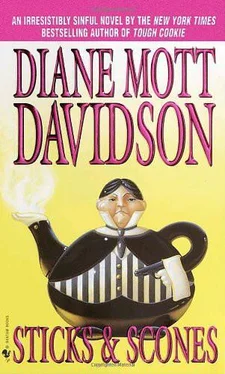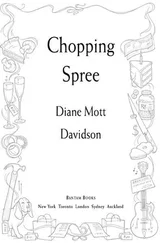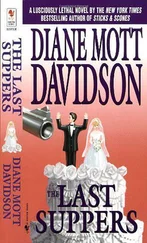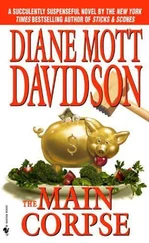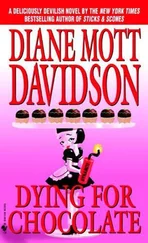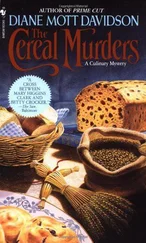Before all hell broke loose on Monday, I’d planned to bring my portable ovens to bake the pies. I often did this for catered events at kitchenless sites; I’d just forgotten to pack them after our window was shot out. Still, after the debacle with the computers, there was no way I was going back to our house to get the portable ovens. Instead, one of us would drive back to the castle to put the pies into the oven at eleven-fifteen. Meanwhile, the other would I keep the appetizers and soup going until the hot pies came down around noon. As long as the tables had been delivered and the labyrinth cake arrived at ten as ordered, we’d be in great shape.
For the pies, I chopped carrots, onions, and parsley for what the French called a mirepoix, and started butter melting in a Dutch oven. Julian steamed the haricots verts, then moved on to preparing a complex sauce. With the mirepoix sizzling in the pool of butter, I sharpened my largest chefs knife before tackling the slabs of steak. Eliot had argued for steak-and-kidney pies, but I’d been adamantly opposed. The Olde English crowd may have loved’ em, but your modern American diner was going to think a kidney tasted like liver, and give it a pass.
“So what did the Elizabethan folks eat besides meat?” Julian asked as he swished balsamic vinegar into the fig salad dressing.
I finished cutting the steaks, floured and seasoned the pieces, and laid them over the sautéed vegetables. “Every meal offered the ever-present manchet bread,” I replied. “It was actually a small loaf. I used Julia Child’s hamburger-bun recipe last week and made a bunch of them, which I brought. Odd as it may seem, sixteenth-century folks also had sweet dishes with each course. At least, the rich ones did. Gingerbreads, tarts, marzipan, and cakes, plus conserves, preserves, and marmalades of every type. Served alongside the cooked sparrows.”
“Now there’s a healthful diet.”
“The theory is that Henry the Eighth died of scurvy.”
“Wha’d I tell you?”
I went hunting for the bottles of burgundy I’d brought in one of my boxes. Judicious amounts of red wine would be poured over the meat mixture, before it was covered with pie dough. With any luck, we’d have juicy, tender, flavorful pieces of steak topped with a golden flaky crust.
Shakespeare’s Steak Pie
This is an expensive recipe. Because tenderloin cooks so quickly and is easily overcooked, it is imperative that you purchase a low-cost meat thermometer with a digital read-out so that the beef is cooked to an ideal medium-rare temperature.
2 tablespoons (1/4 stick) unsalted butter 1 medium or large onion, chopped 1 medium carrot, chopped 2 cloves garlic, pressed and minced 2 tablespoons minced fresh parsley 6 tablespoons all-purpose flour ˝ teaspoon crumbled dried thyme ˝ teaspoon crumbled dried oregano ˝ teaspoon crumbled dried sage 1 ˝ teaspoons salt ź teaspoon freshly ground black pepper 2 1/2 pounds beef tenderloin, trimmed, cut into 1 1/2-inch cubes (You should have 2 pounds of trimmed, cubed beef) 1/4 cup high-quality dry red wine Upper Crust Pastry (recipe follows)
In a wide sauté pan, melt the butter over medium-low heat. Gently sauté the onion, carrot, garlic, and parsley for a moment, stirring until the vegetables are well mixed. Cover the pan and cook over medium to low heat, stirring occasionally, until the onion is limp and translucent and the carrot has lost some of its crunch, about 10 minutes. Uncover the pan and set aside to cool. Place the flour, thyme, oregano, sage, salt, and pepper into a large, heavy-duty zip-type plastic bag and mix well. Add the beef to the bag, zip the top closed, and shake until all the cubes are evenly covered with the dry mixture. Butter a 9 x l2-inch oval au gratin pan. Place the floured cubes into the pan along with the sautéed vegetables, mixing very lightly with your hands, just until the vegetables and meat are evenly distributed. Place the filled pan in the refrigerator while you prepare the crust. (Or you can cover the filled pan with plastic wrap, place it in the refrigerator, and chill until you are ready to prepare the crust and cook the pie. It is best not to prepare the crust in advance.) Preheat the oven to 350°F. Remove the pan of meat and vegetables from the refrigerator and pour the wine into the pan. Gently fit the crust over the pan, fluting the edges and slashing the center in 3 places to vent and decorating the top as I directed in the pastry recipe. Carefully insert the thermometer through a slash in the crust, making sure it spears a piece of beef. Bake until the meat thermometer reads 125 F for medium rare, about 25 minutes. Serve immediately.
Makes 4 large servings
Upper-Crust Pastry:
1 1/4 cups all-purpose flour ˝ teaspoon salt 6 tablespoons (3/4 stick) chilled unsalted butter, cut into 6 pieces 1 egg beaten, 1 tablespoon reserved and set aside 1 tablespoon milk
In the bowl of a large food processor, combine the flour and salt and process for 5 seconds. With the motor running, drop in the butter, one piece at a time. Combine the egg and milk and pour into the food processor. Process for a few moments, just until the dough pulls into a ball. Gently flatten the dough and place it into a rectangular jumbo-size zip-type plastic bag. Using a rolling pin, roll the pastry to the edges of the bag, or until it will fit over your pan. Open the bag at the zipper, and using scissors, carefully cut down the sides of the bag. Remove one whole side of the bag and place the pastry side down on the pan. Gently peel off the top of the bag. Flute the edges of the pastry and make the slashes in the top as directed in the recipe. Using a pastry brush, paint the reserved tablespoon of beaten egg on top of the pastry.
Yikes! I was making myself hungry. Tom must have received my telepathic message, for he chose that moment to amble into the kitchen.
“Enter the one-armed breakfast chef,” he announced jovially. He wore dark chef pants - a gift from Julian - and a buttoned white Broncos shin. “Please don’t try to talk me out of anything. Just give me an apron. I’m not leaving. If either one of you protests, you’ll only raise my stress level and make me ill.”
Julian and I laughed while Tom rooted around in Alicia’s delivered boxes of foodstuffs for chili ingredients. With a pang of guilt, I realized I’d mishandled the confrontation over Sara Beth. Besides, what had I promised myself in the hospital? That I didn’t care if there was another woman; I would love Tom always. Now I just had to behave as if I didn’t care about her.
I sighed and got back to work. Within thirty minutes, Julian and I had completed our preparation. Tom, meanwhile, worked assiduously on his breakfast concoction. The Hydes, wearing matching royal blue robes, floated into the kitchen and offered to prepare juices and hot drinks. Michaela, dressed for coach work, showed up a few minutes later, surveyed the goings-on, and announced she’d toast English muffins for all. I gladly acquiesced. I was ravenous.
Arch appeared just after seven, wearing an oversize olive shirt and large khaki pants. Did anyone at that school actually wear anything in the correct size? Sheepishly, he asked if I’d be willing to wash his fencing outfit today, so he could have it fresh for the banquet. To my surprise, Sukie volunteered to do it; she had state-of-the-art washing and drying machines, she explained, that no one else could understand.
Arch thanked her and peered into the wide frying pan on the stove. Tom was stirring his aromatic, bubbling Boulder Chili: sautéed ground chuck, onions, garlic, chili beans, and the most hearty collection of spices north of the Rio Grande. Arch frowned.
“I’m pretty sure the Elizabethans didn’t have chili first thing in the morning.”
“Oh, yeah?” said Tom. “Too bad. Huevos Palacios are coming up.” His voice was still buoyant, but I could see lines of wear in his face and eyes. Maybe I shouldn’t have let him do any cooking.
Читать дальше
